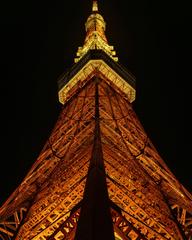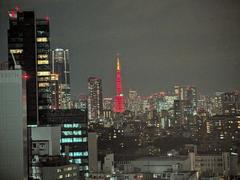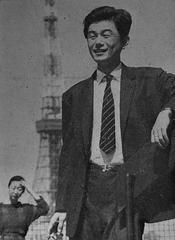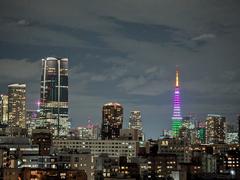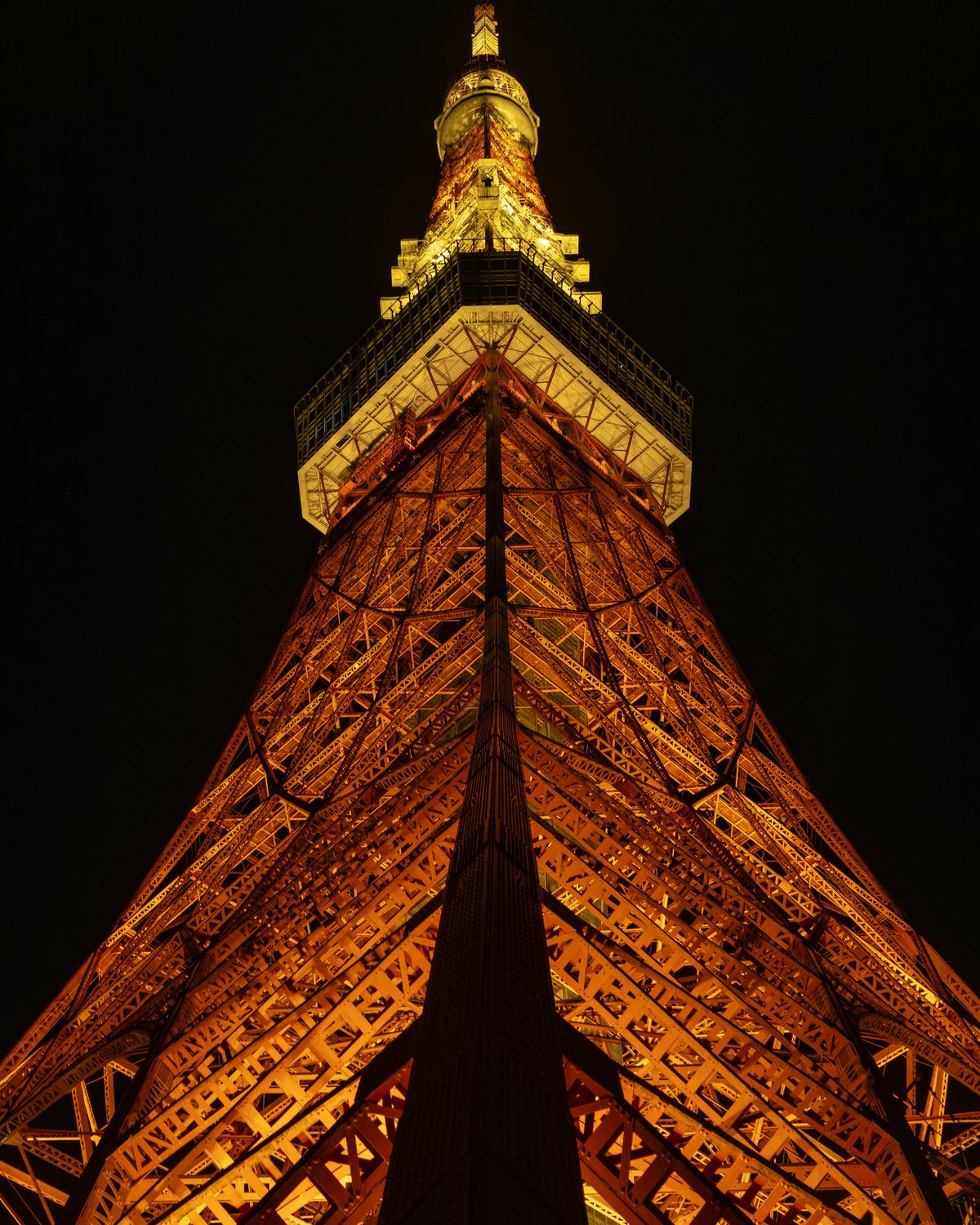
Visiting Tokyo Tower: Tickets, Hours, and Tips
Date: 16/07/2024
Introduction
Tokyo Tower, or 東京タワー, is an iconic symbol of Japan’s post-war rebirth and technological advancement. Erected in 1958, the tower stands at an impressive 333 meters (1,092 feet) tall, surpassing the height of the Eiffel Tower, which served as its inspiration. Conceived as a television broadcasting tower, Tokyo Tower quickly became a beacon of Japan’s resilience and modernization efforts following the devastations of World War II (Japan Guide). Designed by renowned architect Tachū Naitō, known for his expertise in earthquake-resistant architecture, the tower’s construction incorporated over 4,000 tons of steel, much of which was sourced from U.S. tanks damaged during the Korean War (Architectural Digest). Over the years, Tokyo Tower has served its primary function as a broadcasting hub and emerged as a major tourist attraction, drawing millions of visitors annually. The tower’s observation decks offer breathtaking panoramic views of Tokyo, while its distinctive red and white color scheme has become synonymous with the city’s skyline. This guide provides a thorough exploration of Tokyo Tower’s historical significance, architectural marvel, visitor information, and travel tips, ensuring a memorable visit to this emblematic structure (Tokyo Tower Official).
Table of Contents
History of 東京タワー (Tokyo Tower)
Conception and Planning
Tokyo Tower was conceived in the mid-1950s as both a television broadcasting tower and a symbol of Japan’s recovery and modernization post-World War II. The inspiration for Tokyo Tower came from the Eiffel Tower in Paris, and it was designed by Tachū Naitō, a prominent Japanese architect known for his expertise in designing earthquake-resistant structures. Hisakichi Maeda, the founder of Nippon Television City Corporation, initiated the project, envisioning a tower that would surpass the Eiffel Tower in height and serve as a beacon of Japan’s technological advancement.
Construction
Construction of Tokyo Tower began in June 1957 and was completed in December 1958. The tower stands at 333 meters (1,092 feet), making it the tallest structure in Japan at the time of its completion. The construction involved over 400 workers and used approximately 4,000 tons of steel, much of which was sourced from scrap metal from U.S. tanks damaged during the Korean War. The tower’s design incorporates elements of traditional Japanese architecture, such as the pagoda-like structure at its base, which provides stability and aesthetic appeal.
Opening and Early Years
Tokyo Tower officially opened to the public on December 23, 1958. The opening ceremony was attended by various dignitaries, including Prime Minister Nobusuke Kishi. The tower quickly became a popular tourist attraction, drawing millions of visitors each year. In its early years, Tokyo Tower played a crucial role in Japan’s television broadcasting, housing antennas for major television networks such as NHK, Nippon Television, and Tokyo Broadcasting System. The tower’s observation decks, located at 150 meters (492 feet) and 250 meters (820 feet), offered panoramic views of Tokyo and became a favorite spot for both locals and tourists.
Technological Advancements
Over the years, Tokyo Tower has undergone several upgrades to keep up with advancements in broadcasting technology. In the 1960s, the tower’s antennas were modified to accommodate color television broadcasting. In the 1980s, the tower was equipped with antennas for FM radio broadcasting. The most significant upgrade came in the early 2000s when the tower was retrofitted with digital broadcasting antennas to support Japan’s transition to digital television. Despite these upgrades, the tower’s original structure has remained largely unchanged, a testament to its robust design and construction.
Cultural Significance
Tokyo Tower holds a special place in Japanese culture and has been featured in numerous films, television shows, and anime. It is often depicted as a symbol of Tokyo and Japan’s post-war recovery. The tower’s iconic red and white color scheme, chosen to comply with aviation safety regulations, has become synonymous with Tokyo’s skyline. Tokyo Tower has also been the site of various cultural events and celebrations, including New Year’s Eve countdowns, light shows, and charity events. The tower’s illumination, which changes color to mark different occasions, is a beloved feature that adds to its charm and appeal.
Preservation and Renovation
In recent years, efforts have been made to preserve and renovate Tokyo Tower to ensure its continued relevance and safety. In 2012, the tower underwent a major renovation to reinforce its structure and improve its earthquake resistance. The renovation included the installation of new steel braces and the replacement of aging components. The tower’s observation decks were also refurbished to enhance the visitor experience, with new exhibits and interactive displays added. Despite the construction of the taller Tokyo Skytree in 2012, Tokyo Tower remains a beloved landmark and continues to attract millions of visitors each year.
Visitor Information
Visiting Hours and Tickets
Tokyo Tower is open daily from 9:00 AM to 11:00 PM, with the last admission at 10:30 PM. Ticket prices for the main deck (150 meters) are 1,200 yen for adults, 1,000 yen for high school students, and 700 yen for children. Combined tickets for both the main deck and the top deck (250 meters) are 3,000 yen for adults, 2,800 yen for high school students, and 2,200 yen for children. Discounts are available for groups and students.
Travel Tips
- Best Time to Visit: Early morning or late evening to avoid crowds.
- Transportation: Easily accessible via public transportation, with the closest stations being Akabanebashi Station (Oedo Line) and Kamiyacho Station (Hibiya Line).
- Essentials: Bring a camera for the stunning views and wear comfortable shoes for walking around the tower.
Nearby Attractions
While visiting Tokyo Tower, be sure to check out nearby attractions such as Zojoji Temple, Shiba Park, and the Roppongi Hills complex. These sites offer additional cultural and recreational experiences that complement a visit to the tower.
Accessibility
Tokyo Tower is wheelchair accessible, with elevators and ramps available for visitors with disabilities. The tower also offers wheelchairs for rent at the information desk.
Special Events and Guided Tours
Tokyo Tower hosts various special events throughout the year, including seasonal light shows, cherry blossom viewing in spring, and Christmas illuminations in winter. Guided tours are available in multiple languages and provide in-depth information about the tower’s history and features.
Photographic Spots
For the best photos of Tokyo Tower, visit the observation decks or the surrounding areas such as Shiba Park. The tower is particularly photogenic at sunset and during nighttime illuminations.
FAQ
Q: What are the best times to visit Tokyo Tower?
- A: The best times to visit are early in the morning or late in the evening to avoid crowds.
Q: Are there any guided tours available?
- A: Yes, guided tours are available in multiple languages and provide detailed information about the tower.
Q: How much are the tickets for Tokyo Tower?
- A: Ticket prices for the main deck are 1,200 yen for adults, 1,000 yen for high school students, and 700 yen for children. Combined tickets for both decks are 3,000 yen for adults, 2,800 yen for high school students, and 2,200 yen for children.
Conclusion and Call to Action
Tokyo Tower’s history is a testament to Japan’s resilience and innovation. From its conception as a symbol of post-war recovery to its role as a modern-day tourist attraction, Tokyo Tower has remained an enduring icon of Tokyo’s skyline. For more detailed information, visit the official Tokyo Tower website. Also, check out our related posts and follow us on social media for the latest updates and travel tips.
References
- Japan Guide. (n.d.). Tokyo Tower. Retrieved from https://www.japan-guide.com/e/e3009.html
- Architectural Digest. (n.d.). Tokyo Tower History. Retrieved from https://www.architecturaldigest.com/story/tokyo-tower-history
- Tokyo Tower Official. (n.d.). Retrieved from https://www.tokyotower.co.jp/en.html
- Nikkei Asia. (n.d.). Tokyo Tower’s 60-Year Legacy of Economic Impact. Retrieved from https://asia.nikkei.com/Business/Business-trends/Tokyo-Tower-s-60-year-legacy-of-economic-impact
